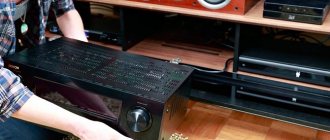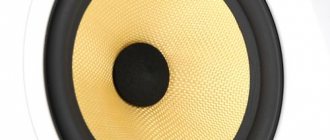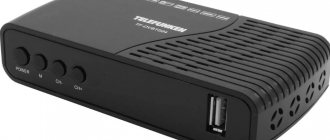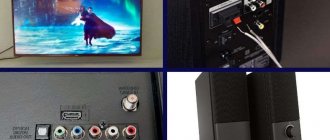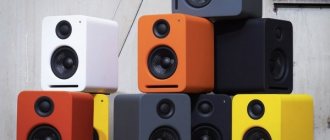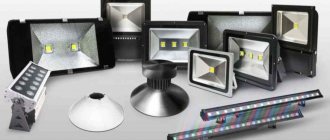Main types of acoustics for TV
Over the years of the existence of the acoustic systems industry, a huge number of different types of acoustics, sound bars, receivers and other sound devices have been produced. Conventionally, all columns can be divided into types according to several parameters:
- design;
- purpose of application;
- active or passive;
- connection method.
Let's look at each type in more detail.
Design
The design largely determines how clear the device will sound. Structurally, acoustic systems can be made in the most intricate forms. But among them three main varieties can be distinguished:
- rectangular;
- pyramidal;
- spherical.
The best quality can be provided by speakers with a rectangular design. However, they must be made of a special material. MDF, fiberboard or chipboard are best suited for this.
Housing features can also affect the sound and its quality. Here you can find 2 types: closed and with a bass reflex. The first is used in most speakers, and the 2 is found mainly in subwoofers.
Purpose of application
Everything is a little simpler here. There are devices capable of outputting two channels, that is, stereo and multichannel systems. Stereo speakers? These are usually two speakers outputting the left and right front channels. The most common and used type.
Multichannel systems are designed in such a way that each set in the system is responsible for the output of a specific channel. Thus, they can still be divided into several types, each for their own channels:
- frontal _ This is the most important device, as it were, the entire backbone of the sound. Quite large, equipped with full-range speakers;
- main column . Often present to give the sound a certain volume and presence effect;
- subwoofer. One single speaker capable of emitting low frequencies, forming bass;
- rear _ Typically these are small devices placed behind the user's back. They create a unique effect of presence and volume;
- satellites. These are small side speakers that perform an auxiliary function and operate in a limited frequency spectrum.
Active or passive speakers
Everything is quite simple here - active ones have a built-in amplifier, which increases their power and signal volume. Passive in most cases require implementation into a ready-made speaker system with an existing amplifier or receiver.
Connection method
According to the connection method, speakers can differ in wired and wireless interfaces. The range of connection options for wired options, in turn, is quite wide. These can be the canonical “tulips”, SCART and HDMI.
The main types of connectors for connecting speakers to a TV
Modern systems can be connected in one of several ways, which involves using the following connectors:
- analog input. The simplest and most widely used connectors. Divided into two channels? left and right;
- SCART connector. Universal connector for both audio and video transmission;
- component connector. Plugs for such a connector are popularly called “tulips”. Also divided into left and right channels;
- HDMI. The most modern and most technologically advanced way to connect. Can transmit digital audio and video up to Ultra HD;
- digital output . Typically connected using an optical connection.
Technical characteristics of TV speakers: how to choose the right one
When choosing speakers for a TV, you cannot definitely say whether they are suitable for a particular model or not. Therefore, there are a number of characteristics that you need to focus on when choosing a speaker system for your TV.
SCART to RCA adapter
Sensitivity
Sensitivity characterizes nothing more than the maximum volume. This value is measured in decibels. In general, the higher the sensitivity value, the louder the system can produce sound from the speakers.
Power
Power is one of the most important parameters of a speaker. Typically there are three concepts of power: rated, maximum and peak. The nominal value is usually indicated in the device passport. Maximum power is the power at which the speaker can reproduce sound for a long time without any physical consequences. Peak power is usually several times higher than the rated power, indicating the value at which the column can operate for a short time without being damaged.
Pay attention to the recommended power of the amplifier, since choosing speakers that it will not “pull” is fraught with low sound quality.
When choosing speakers for your TV, everyone mainly relies on the wattage rating. The larger the area of the room in which the TV is located and the sound from the selected speakers will be heard, the higher the power value should be chosen.
Materials and design
We talked a little about materials at the beginning of the article. A plastic case will cost much less, but the sound produced will be much worse. For TV acoustics, it is preferable to choose wooden enclosures. The design doesn’t really matter, except that it’s better to use a device with a bass reflex.
Connecting speakers to your TV
The connection type should be chosen based on the TV outputs. Basically, any model is equipped with several types of connectors, leaving freedom of choice to the user. In addition, new modern models are equipped with wireless modules and Bluetooth.
Wide range of outputs on your TV
Main selection criteria
It will be quite difficult for the average person to navigate the variety of technical characteristics and features of each type of speaker. Now we will move on to consider the main technical characteristics.
Sensitivity
A characteristic that describes how sensitive the speaker system is to the input signal. Measured in dB/W/m. Tells how loud the speaker will sound in dB when a 1 W signal is applied at a distance of 1 m, measured on the emission axis. Typical sensitivity values are 84-97 dB/W/m.
Since the decibel is a logarithmic value, then increasing the volume of the speaker system by 1 dB, you need to increase its power by 1.25 times, by 2 dB - by 1.6 times, and by 3 dB - by 2 times, etc.
Sensitivity is measured by applying a signal with a frequency of 1000 Hz.
Power
Measured in Watts.
It is the power of the electrical signal at the output of the amplifier; there is also the concept of speaker power, which is important when choosing speakers. The power of the amplifier is limited by circuit solutions and power elements. The power of the speakers is limited by the mechanical strength of the cones and the electrical characteristics of the coil. If the choice is between passive acoustics options, note that the amplifier power must be less than the power of the speakers , otherwise they may fail when you turn the volume knob to maximum.
Impedance
This is the total resistance of the speakers (active and inductive reactance), measured in Ohms. It is important when choosing a passive speaker - it must comply with the permissible operating modes of the amplifier.
Impedance graph example
Interfaces for connecting to a sound source
First, let's note that audio is an analog signal. However, connectors or interfaces for connecting a speaker system (amplifier) to a sound source are divided into three types:
- Analog;
- Digital;
- Wireless. They are also digital nowadays.
Let's look at typical connector options.
Tulips-RCA and 3.5 mm - analog connectors
To connect speakers to the TV, RCA type connectors are used, or as they are popularly called “Bell” or “Tulip”. It is a round coaxial connector with a signal plug at the end and a shielding skirt around it. Typical colors in a stereo speaker are white for the left speaker and red for the right. The sound output on a TV or player is designated as AUDIO OUT.
Tulips - RCA and 3.5 mm
At the same time, speakers are connected to wearable players, phones and computers via a 3.5 mm connector; by the way, this is also found on some portable TVs. Both connectors are analog.
Advice! There are cords available for sale - RCA-RCA, RCA-Jack 3.5 mm, Jack 3.5 mm-Jack 3.5 mm, the latter is often called an AUX cable. Therefore, you can always find the right option for your system.
Universal SCART connector
It is used for both video and audio transmission, and also transmits a digital signal - commands to the TV. Currently going out of use.
Universal SCART connector
Optical interface
Serves to transmit digital images and audio signals. Provides high quality sound.
HDMI connector
A modern connector for transmitting digital signals (information, video and audio). Provides sound quality and is supported by the vast majority of modern technology.
HDMI connector
Wireless signal transmission
Bluetooth and Wi-Fi have become the basis of modern communications. The Internet and data are most often transmitted through these technologies. There are a lot of speaker systems on the market that work via Bluetooth. Xiaomi is making good progress in this direction. However, there are certain nuances:
- The quality is close to the CD-audio format;
- The main scope of application is related to portable speakers and small systems of the 2.0 - 2.1 type; due to technological factors, it will not be possible to fully reveal the advantages of 5.1 systems and the like.
Housing material
Both sound and performance characteristics depend on the choice of material. Speaker systems are made from:
Speakers made of wooden materials System made of plastic
Review of models of inexpensive, small and powerful TV speakers
Next, we will look at what the modern TV speaker market offers us. It is worth mentioning that there are no specific speakers specifically for TVs, as such, since almost any can be connected.
Genelec 4010A
This is a simple two-way speaker system with two speakers. The total power is 30 W. Reproducible frequency range? from 60 to 20000 Hz. The material used is plastic. Interface for connection - linear input. Perfect for assembling an inexpensive and simple TV speaker system.
Genelec 4010A
Price: RUB 11,452
Sony SA-CS9
An ordinary free-standing floor-standing subwoofer. Active, inverter type. There is only 1 audio band. Its power is 80 W. The range of reproduced frequencies varies from 40 to 250 Hz. The connection is made via a linear input. Suitable for expanding the standard TV acoustic system.
Sony SA-CS9
Price: RUB 10,789
Tascam VL-S3BT
2 active bass reflex devices. Capable of producing two bands of sound. The total power is 14 W. The range of reproduced frequencies ranges from 80 to 22000 Hz. Connection is possible via line input. An excellent solution for both TV and computer.
Tascam VL-S3BT
Price: RUB 10,186
Magnat Tempus Center 22
Active two-way speaker system. Has its own amplifier. A bright representative of wireless speakers for TV. The total power is 54 W. The material from which the speakers and amplifier are made is plastic.
Magnat Tempus Center 22
Price: ₽ 9,000
CVGaudio NF4T
CVGaudio NF4T
Suspended passive speaker system. There is one 2-way speaker. Sensitivity is 88 dB. The frequency varies from 120 to 19000 Hz. Connection is possible through an amplifier, receiver or home theater.
CVGaudio NF4T
Best models
On sale today there are a large number of models of audio systems for front-facing, floor-standing, wall-mounted and other types of TVs. TV speakers differ from each other in power, sound quality, interface type and other parameters. Speakers that connect to TV wirelessly have become quite common today. The main thing in this case is that the connection between the devices is stable, otherwise there will be a loss of sound. Top models include:
- Yamaha NS-F160;
- JBL Studio 130;
- JBL Studio 580;
- Sony HT-CT380;
- HECO Music Style 25A;
- Monitor Audio Bronze;
- Heco Celan GT 302;
- BBK MA-970S;
- Sonos Playbar;
- Samsung HW-K360 and others.
Acoustic speakers are subject to a number of mandatory requirements that they must meet. It is desirable that they have:
- Power. This parameter indicates the ability of audio systems to keep the volume at the proper level.
- Good sensitivity. It makes the sound clearer at any volume level.
- Smart design. Thanks to it, when correctly placed, the speakers in the room will provide the necessary spatial sound.
- A size that matches the parameters of the room.
- Functionality. Speaker systems (floor-standing, bookshelf) have different tones, which affect the sound.
Wireless speakers for TV
Sony HT-CT390 is a wireless speaker for a 2.1 TV, which is suitable for installation in a large room. The total power of 300 W is unlikely to be fully used, because... The soundbar is not designed for maximum loads - gradually it will begin to hum and whistle slightly. At lower volumes, watching movies with this model is a pleasure. The device is wireless, because supports Bluetooth. There is a voice enhancement mode. This soundbar can be turned into a full-fledged music center by simply plugging in a flash drive with music:
- name: Sony HT-CT390;
- price: RUR 18,499;
- characteristics: standard – 2.1, type – active sound panel, power – 300 W, speakers – 1 ceiling, dimensions – 90x12.1x5.2 cm, weight – 2.2 kg, there is a subwoofer (17x34.2x36.2 cm, weight 6 .2 kg) with a 13 cm speaker, interfaces – HDMI, USB Type A, NFC support, Bluetooth;
- pros: there are fastenings for installation, clear sound, decent power, simple controls, wireless connection;
- cons: many sound settings, relatively small display.
Active speakers
If you are interested in active acoustics for a home theater, then take a closer look at the Samsung TW-H5500 speakers, which provide rich, surround sound with minimal distortion. The model is compatible with almost all modern devices, for example, a player, a TV, and various kinds of mobile devices. Synchronization is carried out via Bluetooth or RCA, USB, 3.5 mm input. The device plays MP3, WMA files. Additionally, the speakers are equipped with DTS and Dolby Digital decoders, which creates the effect of being in a movie theater:
- name: Samsung TW-H5500;
- price: 20390 rub.;
- characteristics: total power – 350 W, bass enhancement – 1 level, case material – MDF/plastic, has a built-in Bluetooth module, dimensions of front speakers (2x175 cm) – 98x20x29.5 cm, resistance – 4 Ohm, weight – 55 kg, black color;
- pros: sound quality, assembly, almost universal, convenient connection;
- Cons: They don't play very well at low volumes.
Floor-standing
In Moscow, St. Petersburg and other cities of the country you can find dozens of floor-standing speaker models, one of which is an innovative solution from the Yamaha brand - NS-F160. The acoustic properties of this module are enough to create a home theater without investing too much money in its creation. This two-way bass reflex floor standing speaker is equipped with a front speaker:
- name: Yamaha NS-F160;
- price: RUB 11,865;
- characteristics: type - two-way floor-standing, maximum power - 300 W, frequency range - 30-36000 Hz, sensitivity - 87 dB, impedance - 6 Ohms, separate connection for HF, LF, dimensions - 21.8x104.2x36.9 cm, weight - 19 kg, has a removable grill, magnetic protection;
- advantages: stability and structural strength, high-quality assembly, high degree of power, relatively cheap;
- Cons: not the strongest microdynamics, requires a long “warm-up”.
Frontal
Wharfedale Obsidian 600 5.0 is a high-quality speaker for a room with an area of 30 m2, which was produced by a British company with a 70-year history. The audio system, optimally suited for a home theater setup, consists of a pair of front speakers, a pair of rear speakers and a center channel system - their total power is 375 W. The woofers and mid-range speakers are made of woven Kevlar, which is impregnated with a special polymer - due to the additional rigidity, the sound becomes clearer. This model has a good price-quality ratio:
- name: Wharfedale Obsidian 600 5.0;
- price: 54400 rub.;
- characteristics: type – passive, front speakers – 2 floor-standing, number of bands – 3, frequency range of the front channel – 40-20000 Hz, rear – 80-20000 Hz, center – 75-20000 Hz, channel sensitivity – 89, 88, 88 dB ;
- pros: powerful, clear and spacious sound, rich bass, decent frequency range, Kevlar speakers;
- cons: expensive, rear speakers are not powerful enough.
Wall mounted
Check out the ultra-compact JBL C62P outboard speaker for use with the 40CS/T or Control 50S/T subwoofers. You can order this model of audio system for TV in a specialized online store with delivery by mail. The device has a 140° conical direction, IP44 protection, and galvanized powder-coated steel mesh. The suspension is made using two reinforced 4.5 mm cables, which are included in the kit:
- name: JBL C62P;
- price: 4609 RUR;
- characteristics: color – white, width – 12.8 cm, depth – 14.1 cm, weight – 0.7 kg, speaker – 50 mm, number of bands – 1, frequency range – 150-20000 Hz, sensitivity – 84 dB, impedance – 16 Ohm, rated power – 30 W;
- pros: relatively light, compact, cheap;
- cons: low power.
- How to remove cheeks and make cheekbones at home
- Why hair ends split: care for curls
- Pumpkin pancakes: delicious recipes with photos
Subwoofer
Pay attention to the Yamaha YST-FSW100 subwoofer, made in a stylish narrow body. The device is an excellent solution for complementing TVs, especially thin LCD ones. A distinctive feature of the model is the use of Advanced YST, a technology that suppresses impedance through the interaction of the amplifier and speaker. An acoustic device can remain operational even under high loads:
- name: Yamaha YST-FSW100;
- price: 9960 rub.;
- characteristics: type - active, maximum power - 130 W, speaker size - 16 cm, frequency range - 30-200 Hz, color - black, dimensions - 40x37.5x15.7 cm, weight - 8.1 kg;
- pros: deep bass, build quality, reasonable price;
- cons: small frequency range, simple design.
Soundbar
You can practically transform your TV into a Smart TV by connecting it to a soundbar. The TV audio system in the form of the 2.1-channel wireless subwoofer HW-K360 from Samsung is an excellent option that can be installed almost anywhere. The model is not professional, but it can significantly improve the sound of television speakers. The subwoofer, like many other speakers, is controlled using a remote control. The model has a panel with a plastic body, which is decorated in black:
- name: Samsung HW-K360;
- price: 10990 rub.;
- characteristics: color – black, dimensions – 96.5x7x5.4 cm, weight – 4.4 kg, interfaces – microUSB 2.0/Toslink (optical input)/3.5 mm audio input, front speaker power – 2x35 W, impedance – 6 Ohm, Bluetooth support, Dolby Digital, DTS decoders, subwoofer dimensions – 30x15.5x29.3 cm, power – 60 W;
- pros: variety of settings, low cost, wireless connection;
- Cons: relatively simple design, no HDMI port.
With optical TV input
A good purchase might be the Sonos Playbar active soundbar with 9 speakers, each of which is equipped with its own Class D amplifier. To start working with this device, you need to plug one optical cable into the TV and the second into a power outlet. This soundbar can be integrated into almost any speaker:
- name: Sonos Playbar;
- price: RUB 59,990;
- characteristics: overall dimensions – 90x14x8.5 cm, interfaces – optical input (Toslink), LAN connector (RJ45), front speakers color – black, weight – 5.4 kg, wall mounting;
- pros: there is Wi-Fi support via a built-in module, simple control and configuration, excellent design, you can play music from cloud storage;
- Cons: lacks bass, limited scope.
Acoustics for LG TV
For an LG TV, the SJ3 soundbar is a good purchase. It comes in the form of a thin soundbar that has a minimalist design and very powerful speakers. The latter are capable of filling even a relatively large room with sound vibrations:
- name: LG SJ3;
- price: RUB 14,990;
- characteristics: dimensions – 95x4.7x7.1 cm, weight – 9.5 kg, color – black, front speaker power – 2x50 W, impedance – 4 Ohms, Bluetooth support, subwoofer – wireless 200 W, case material – plastic/MDF ;
- pros: modern design, good sound, stable connection with a smartphone when playing music via Bluetooth;
- Cons: The kit does not include a cable for connecting to the TV.
Philips
Those who are planning to get speakers for their Philips TV should take a closer look at the Philips CSS7235Y/12 soundbar. This system will help you enjoy deep and spacious sound. It is equipped with removable and wireless rear speakers and a subwoofer. There are high-quality soft dome tweeters. Bluetooth (aptX and AAC) is used for wireless music streaming:
- name: Philips CSS7235Y/12;
- price: 41,000 rub.;
- characteristics: type – 4.1, total power – 210 W, there is a wireless subwoofer 90 W with a frequency range of 20-150 Hz, front speakers 2x30 W with a frequency range of 150 Hz-20 kHz, weight – 11.9 kg, color – silver/black ;
- pros: functional, supports many interfaces;
- cons: high cost.
Samsung
If you are looking for speakers for Samsung TVs, then check out the characteristics of the SWA-9000S speakers. This home audio system is presented in a wall-mounted version, and it is compatible with several other devices: HW-MS650, HW-MS6501, HW-MS6500. The back side of the case is made of plastic:
- name: Samsung SWA 9000S;
- price: 9990 rub.;
- characteristics: dimensions – 8.8x8.8x14.7 cm, weight – 1.9 kg, color – black, total power – 54 W, sound system – 54 W, frequency range – 20 Hz-20 kHz, rear speakers – wireless;
- pros: reasonable price, good functionality, powerful sound;
- cons: not the most aesthetic design.
Acoustics 5.1
When planning to equip your Panasonic, Mystery or other well-known brand TV with speakers to create the necessary atmosphere when watching movies, check out the available 5.1 acoustic options. An excellent purchase would be the Polk Audio TL1600 speaker set, which belongs to the latest Blackstone line. The satellite housings are cast from a special composite, which improves sound quality:
- name: Polk Audio TL1600;
- price: RUB 47,390;
- characteristics: color - black, weight - 14.8 kg, frequency range of the central channel - 95-22000 Hz, rear system, front and subwoofer - 135-22000 Hz, acoustic design - with bass reflex, resistance of each element - 8 Ohms,
- pros: functionality, good sound level, there is a 100-watt amplifier;
- cons: no remote control, expensive.
Acoustics 2.1
The Sven MS-1820 2.1 speaker consists of two satellites and one subwoofer. To control this system, a mode switch button and a remote control are used. It is possible to generally adjust the frequency characteristics of the sound and volume using manipulators located on the subwoofer body. The speaker housing is made of durable plastic:
- name: Sven MS-1820 2.1;
- price: 2680 rub.;
- characteristics: frequency range of the subwoofer - 40-150 Hz, satellites - 150-20000 Hz, power - 18 and 2x11 W, speaker sizes - 92 and 57 mm, dimensions - 16.4x23.3x25 cm for the subwoofer and 9x13x8.3 cm for the satellites , there is a digital LED display, magnetic shielding;
- pros: functionality, low cost, ability to play music from SD memory cards and USB drives;
- cons: mediocre quality.
How to connect speakers to a TV
In general, connecting speakers to a TV is not very different on different models of different brands. Almost all of them have the same set of connectors. But still, let's take a look at how this is done using the example of a couple of brands, a subwoofer, an amplifier and computer speakers.
How to connect speakers to an LG TV
You can connect speakers to an LG TV using several connectors: SCART, tulips, linear outputs, HDMI and wireless connection. It’s worth mentioning right away that the SCART connector is not present on all models.
If your TV and speakers have SCART, then just connect them. If there is no connector on the speakers, you can use an adapter with SCART on one end and ? "tulips". Is such an adapter officially labeled as SCART? RCA.
“Tulips” are the most common types of connectors. Therefore, no problems should arise here. We connect the left channel to the left, right? to the right. The linear output on a TV can be identified by special terminals. The connection occurs directly to the plus and minus contacts. The first corresponds to the red color of the terminal, the second - black.
HDMI is probably the highest quality way to transmit sound from a TV to speakers. True, this most likely won’t be possible with regular speakers. Because HDMI is present mainly in complex devices, such as home theaters or receivers.
Using Bluetooth, you can connect your speakers to your TV without any wires. The setup is done through the menu of the TV itself. You need to find the Bluetooth function, activate the device search and connect the found speakers.
How to connect speakers to a Samsung TV
In fact, the method described for LG is also suitable for connecting speakers for a Samsung TV. The same set of connectors and connection methods are available. Except that some models may be equipped with a special headphone output or the so-called Mini-jack.
Unusual acoustic design
The cable for connecting speakers in this way usually has a standard 3.5 mm plug on one side, and a ? “tulips” or analog connectors. Before connecting the speakers to your Samsung TV, you should make sure that the necessary adapters are available.
How to connect a subwoofer to a TV
Subwoofers, like speakers, can be active or passive. This means that the connection method for different types may be different. Active subwoofers simply need to be connected with a cable, adjust the sound in the TV menu and listen to the test track. The situation with passives is a little more complicated. It is impossible to connect them directly. And therefore, either home theater or receivers are used for this. That is, in essence, the subwoofer is first connected to a common speaker system, for example, a home theater or set-top box, and then all this is connected to the TV. But it is worth noting that most of these systems already have their own subwoofer.
Wireless Sub from Sony
How to connect an amplifier to a TV
ATTENTION!
Before connecting the speakers to the TV, you need to make sure that you have all the necessary adapters and the cables match the connectors.
All methods for connecting amplifiers and additional audio devices come down to how correctly the type of cable and connectors will be selected, and are there adapters from one type or another to the one of interest? Old amplifier systems can be connected using a SCART-RCA connection.
Newer amplifier models are usually included in a variety of receiver systems, DVD players, and home theater systems. You can also try using a standard headphone jack, if available. True, you still have to look for an adapter from this connector.
How to connect computer speakers to a TV
Connecting computer speakers? this is probably the easiest way. In most cases, regular acoustics from a computer are active. That is, it has its own sound amplifier. Most often they are connected to a computer using a 3.5 mm connector. If your TV has such an output, then simply connect them. If there are other connectors, then you will have to find an adapter from 3.5 mm to the one you are interested in.
How to choose speakers for your TV
In order not to get confused in all the variety of acoustics options for a TV, it is worth considering the parameters presented below.
Types of columns
There are several options for TV speaker systems.
- Simple columns. These are systems 2.0, 2.1, 5.1, which are often purchased for PCs, but nothing prevents you from connecting them to a TV. Among the advantages are that they are inexpensive, easy to connect, do not require settings and take up little space.
- Soundbar or soundbar. In its original form, it is a narrow speaker equipped with several speakers. It is convenient for placement; you can put it under the TV on a cabinet or hang it on the wall. In more advanced versions, rear satellites and a subwoofer can be added. Today this is the most common type, produced by many manufacturers - from Samsung and LG to audio giants Pioneer and Yamaha.
- A home theater is considered the highest quality solution, since it includes several speakers with different locations, an amplifier, a subwoofer, and often a device for playing content (Blu-ray player). The downside is that it requires fine tuning and installation, and the price tag for good kits is very expensive.
Configuration
The kit may offer multiple speakers. Such systems are called 2.0, 2.1, 5.1, 7.1 and even 9.1.
The following channels are distinguished:
- The front channel is the basis for any sound. If there is no subwoofer included, the front takes over the function of reproducing low frequencies. If the set includes more than two speakers, then the front ones are the largest and most powerful. They have 2-3 speakers.
- The central channel is responsible for mid frequencies, that is, it more accurately conveys the voice, which provides a kind of immersion effect.
- Rear - usually small speakers installed at the rear have a small frequency spectrum and create volume.
- Satellites - side speakers, also aimed at providing volume, help the rear ones.
- The subwoofer is responsible for low frequencies and adds bass to the sound.
Gain type
Speakers are divided by type of amplification into passive and active. For the former, it is located separately (in professional systems they are completely purchased in addition), for active speakers it is built-in.
Passive speakers are convenient because they produce clearer sound and are more powerful (and can also withstand high loads). The disadvantage is that a separate amplifier is required, which also takes up space.
Active devices are less powerful, may not withstand heavy loads (not dangerous when used with a TV), and as an advantage, they can be powered directly from USB or an electrical outlet, take up less space, and the sound quality is quite decent, sufficient for a TV.
TV connection method
You can connect speakers to your TV via:
- 3.5 (mini-jack) - the simplest option, convenient for regular speakers;
- RCA (tulips without a yellow plug) - act as an alternative to 3.5;
- HDMI - used in acoustics designed specifically for TV;
- optical - also used in professional acoustics (most often in home theaters), it is considered to be the best in terms of audio signal transmission quality.

